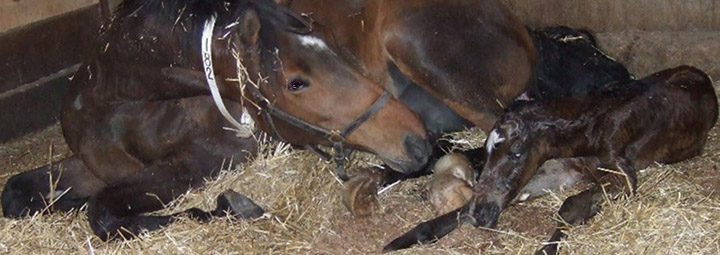Lessons from the immune system of the foal
 Our laboratory has been interested in learning about the competent and not so competent elements of the immune system of the foal. Our approach starts at fetal and neonatal stages of life, learning about the expression of essential B cell developmental genes in the primary and secondary lymphoid tissues. The understanding of B cell development in the equine neonate gives us the important background knowledge for the study of B cell depletion in horses with CVID. In addition, we are interested in the innate immune response of the foal, which is critical for the naïve phase of the immune system until exposure to pathogens in the first few days of life. Therefore, we have studied the function of phagocytes and the expression of inflammatory cytokines in the healthy and sick equine neonate. In addition, we have a better understanding of how dendritic cells of foals respond to bacterial infection or molecular patterns (e.g. CpG-ODN, LPS) and become activated, a step required for the priming of T cells and development of acquired immunity.
Our laboratory has been interested in learning about the competent and not so competent elements of the immune system of the foal. Our approach starts at fetal and neonatal stages of life, learning about the expression of essential B cell developmental genes in the primary and secondary lymphoid tissues. The understanding of B cell development in the equine neonate gives us the important background knowledge for the study of B cell depletion in horses with CVID. In addition, we are interested in the innate immune response of the foal, which is critical for the naïve phase of the immune system until exposure to pathogens in the first few days of life. Therefore, we have studied the function of phagocytes and the expression of inflammatory cytokines in the healthy and sick equine neonate. In addition, we have a better understanding of how dendritic cells of foals respond to bacterial infection or molecular patterns (e.g. CpG-ODN, LPS) and become activated, a step required for the priming of T cells and development of acquired immunity.
Despite great need, the value of preventative neonatal vaccination strategies is controversial: traditional concerns exist with the interference of passively transferred maternal antibodies and the level of immaturity of the innate and adaptive immune system at birth. However, fully mature, functional, and protective immune responses have been reported during the neonatal period after some types of vaccines, which suggest that the use of the appropriate strategy at this developmental stage is valuable.
We are employing the diversity of antigen-specific B cell-surface immunoglobulin heavy chain variable regions [V(D)J] as a novel read-out for vaccine responses. This powerful method presents a major advantage because the analysis of antibody diversity using variable region gene sequence is not confounded by the circulating maternally-derived antibodies acquired through the colostrum. Further, this sequence will reveal the extent of diversity present, which corresponds to the affinity of the antibody generated in response to the vaccine protein as well as the level of maturation achieved by neonatal B cells. This B cell response is dependent on appropriate co-stimulation from T helper cells, which requires appropriate signaling from antigen presenting cells. Using transcriptome sequencing, we are obtaining information on the gene expression profile of neonatal antigen presenting cells in the context of age and antigenic exposure.


